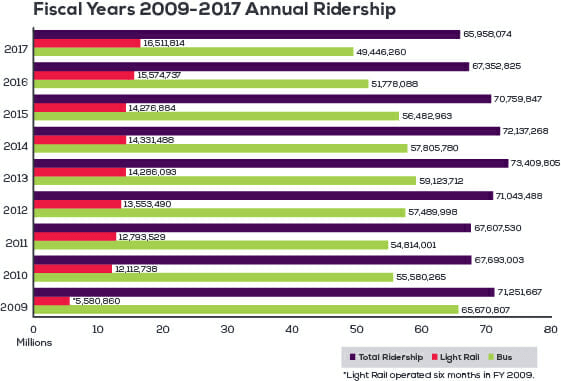Phoenix Transit Ridership Continues to Fall as Light Rail Investment Goes Up
Well, the numbers are in for the 2017 fiscal year (which ends June 30) and after another huge investment in light rail, Phoenix has lost more transit ridership. From the Valley Metro web site:
First, credit where it is due. After years of bizarre chartsmanship where bars on their graphs bore only a passing relationship to the numbers being graphed, Valley Metro seems to have adopted a new (or their first) graphing program.
As you can see, while light rail trips were up by about a million, bus trips were again down by over 2 million, for a net loss in transit ridership of over a million, the fourth year in a row this has been the case. I had expected rail ridership to rise, since in 2016 the rail system was expanded by 31% in length and 36% in cumulative investment. This extension resulting in a 15.6% increase in rail ridership between 2015 and 2017. Early on, I got in a debate with supporters of the line arguing that since they had cherry-picked the densest corridor in town to start, incremental extensions would actually reduce ridership per mile because they would be serving less promising routes. Supporters argued that I was ignoring network effects and that ridership would rise faster than line length. I guess we are sorting out that argument now.
In the ten years leading up to the opening of the light rail line, transit ridership grew by an average of 6.7% a year in Phoenix. In the 8 years since the rail line's opening, total transit ridership has fallen 1% per year. This is a well known effect (at least well known to all but rail die-hards) that Randal O'Toole, among others, has been pointing out for years. Since light rail is an order of magnitude more expensive to operate per passenger-mile, and since transit budgets are never infinite, growing light rail tends to strangle bus traffic, because bus routes and service have to be cut to feed money into the light rail money pit. Since every dollar spent on rail moves fewer passengers than a dollar spent on buses, transferring money from buses to trail reduces total ridership. It is worth noting that had the line not been built and bus transit had been allowed to grow as it had before the line, there might have been over 40 million more trips last year assuming pre-2009 growth rates.



